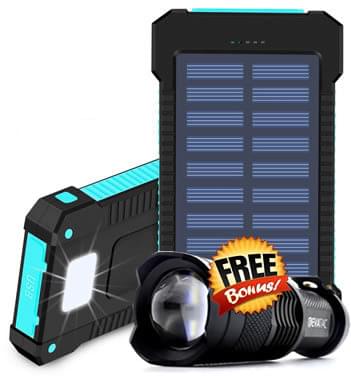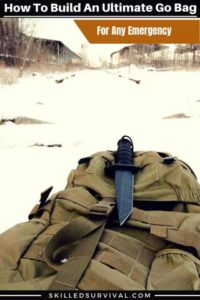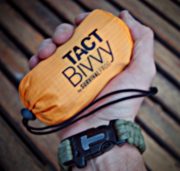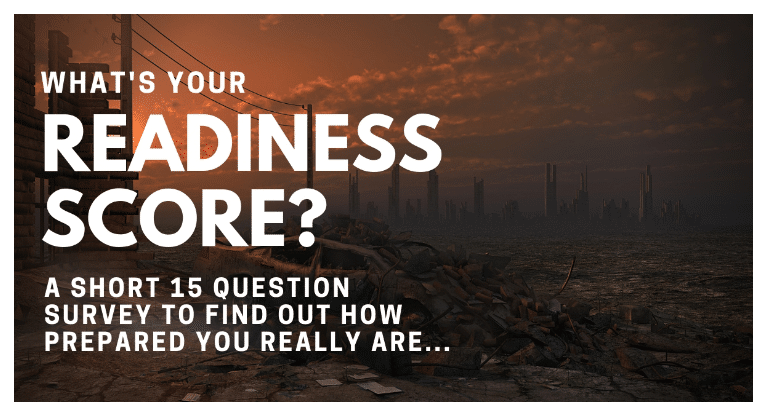How To Build A Go Bag List For Any Emergency
No two emergency go-bag lists are the same.
With that said, I believe EVERYONE should build one!
Every evening I turn on the news, and far too often, I witness another community in turmoil.
From wildfires and blizzards to social unrest, mass shootings, and terrorism…
It never seems to end!
Watching the tear-filled interviews with those who’ve lost everything saddens me.
Often left with nothing but the clothes on their backs.
Grateful to be alive but wish they’d taken time to prepare.
But they “never thought in their wildest dreams it would happen to them.”
Whenever I hear these words, I’m glad I took the time to prepare each family member an Emergency Go Bag.
And even one for my pets!
So today, we’re going to cover everything I know about building an emergency go bag, specifically:
-
Leaving Fast With An Emergency Go Bag
-
Go Bag List First 4 Critical Go Bag Objectives
-
Go Bag Contents – Everything Else
-
Choosing The Right Go Bag To Carry Your Gear
UPDATE: I recently published a new video going over my own go-bag build.
I highly recommend checking it out and then reading the rest of this article for more go-bag gear ideas – “Just In Case” Jack
↓ My Exact Bug Out Bag Build (How To Build A Bug Out Bag) ↓

Are You Ready For The Tough Times Ahead? Take My 60 Sec Quiz To See If You’re Part Of ‘The Fragile Masses’ Or Not… Start Quiz Now!
Leaving Fast With A Go Bag
When I put my first survival bag together, it was a great exercise in evaluating what’s really most important in an emergency.
Over the years, the contents have changed, and I’ve rebuilt them several times over.
But they were never really tested – until they were…
But just months after moving into our new house, I stepped out onto the patio to find the sky full of smoke.
We quickly loaded up the car with our Go Bags and the pets and checked the TV and radio for information.
It turned out that we were never in any real danger. The fire department quickly put out a grass fire on the edge of town.
But now I know better!
We can get out of our house in under 10 minutes with all the critical gear, supplies, and documents we need to survive!
So, what does it take to put together a go-bag list to help you face an emergency?
It can feel like there are so many things to consider that you’ll never finish.
But like most tasks, it comes down to breaking your go-bag list down into manageable objectives.
Then working through the plan step-by-step.
↓ Basics Of Go Bags 3-Day Assault Packs ↓
Go Bag List – 4 Critical Go Bag Objectives
First off, there are four critical objectives to take care of before you move on to the rest.
They’re often referred to as the Rule of 3’s.
These resources you will need in any situation should form the core of your go-bag checklist.
 1. Air
1. Air
You can survive for about 3 minutes without air.
Even if you’re not completely cut off from the air, smoke, dust, pollen, and gases can make breathing difficult.
Gas Masks
At a minimum, keep a face cloth shield and a few 95 masks in your go bag to help clean up the air you inhale.
But if you’re worried about nuclear fallout or even chemical attacks – you’ll need a full-fledged gas mask.
Note: Our favorite gas mask vendors are MIRA Safety and Parcel Distribution!
Medications
If you’ve allergies or asthma, keep a supply of your medications or a spare inhaler in your bag.
Add an Epi-Pen if you or someone you know has an allergic reaction and can’t breathe.
 2. Shelter
2. Shelter
You can survive for 3 hours without shelter in dangerous temperature conditions.
But in the most extreme environments, that number is reduced drastically.
That’s why you should pack a survival blanket or a bivvy sack.
These survival devices can mean the difference between life and death in bad weather.
You could also add a tent hammock for extra comfort without adding too much weight.
If you plan to travel with others, you can also look at larger group shelters such as a survival tent or even just a survival tarp.
The TACT Bivvy is a simple, lightweight survival blanket.
It will keep you alive with its airtight Mylar material, locking in your body heat even in the dead of winter.
↓ Go Bag Shelter – Survival Frog TACT Bivvy Review ↓
3. Water
You can survive for 3 days without water.
Water is critical for survival, so make sure you always have access to clean, safe water.
I keep several single-wall water bottles in my Emergency Go Bag (about a gallon total).
The amount I carry is a personal choice based on the weight of water and our wet Pacific Northwest climate.
I also carry a small survival water filter to refill bottles from any available water source.
That way, I don’t have to only rely on scarce tap water.
The Sawyer mini is both small and powerful. It can filter 100,000 gallons before it’s used up – that’s a whole lot of water!
↓ Sawyer Mini Water Filter Review – Can This Filter 100,000 Gallons Of Water? ↓
 4. Food
4. Food
Sure, you can survive 3 weeks without food, but who would want to?
Your mental and physical performance will suffer quickly without energy.
If you’re not keeping up with the calorie demands, you quickly enter an agonizing state of starvation.
This can lead to poor decisions and fatigue when you can least afford it.
So pack a few lightweight, freeze-dried meals and some calorie-dense snacks.
These will help to keep your energy up and avoid starvation.
Plenty of products out there provide a “full meal” in the form of a small bar.
But I’ve found that most of them taste horrible, and I don’t end up eating them. It’s worth it to try a few and see which ones you like best.
I know it’s an emergency, and calories are calories, but eating them shouldn’t be a chore.
And remember, even survival food will eventually expire. So occasionally rotate your go bag food to keep it fresh.
Our “go-to” recommended freeze-dried food for bugging out is Mountain House.
They allow you to add boiling water directly to the pouch – so you don’t need any extra bowls or cups for mixing or cooking.
Saving you both precious ounces and space for other gear.
↓ Mountain House Food Review – Is This The Best Go Bag Food? ↓
Exclusive Bonus Content – Skilled Survival’s 104 Item Bug Out Bag Checklist – the only bug out checklist worth using. Click Here To Get Your FREE Copy Of It.
Go Bag Contents – Everything Else
Once you’ve got these four critical objectives handled, you can focus on the rest of the contents of your emergency go bag.
Again, take each of these objectives separately and work through them.
These are still critical items, so consider each one and make sure you know how it fits into your plans.
Weight is ALWAYS a factor since you’ll carry everything on your back. If there are lightweight versions of your gear, see if they present an advantage to trade up.
Clothing
Your clothes in an emergency can make a huge difference.
Proper, high-quality clothing that will last is worth the investment.
Environmental conditions will change the types of clothes you need, so it’s best to keep up with the seasons.
For example, taking out the heavy winter coat in the summer means more space and weight savings.
Sturdy Gloves
Keep a pair (maybe two) of durable gloves in your bag.
They can be cold-weather gloves, even in the summer.
They won’t add much weight or take much extra space, and your hands won’t contribute that much to overheating.
Leather-palmed gloves will also protect your hands from more than just the cold:
- blisters from working with tools
- hot cooking pans
- splintered firewood
- broken glass
These can all injure your hands and leave you less able to take care of yourself.
Worse yet, an infection could be the end if you’re not able to find any antibiotics!
Hat
You often hear the head can lose heat faster than the rest of the body. That’s why I keep a baseball hat and a windproof fleece beanie in my bag.
I can wear them separately or together, depending on whether I need protection from the sun, cold, or both.
Waterproof Jacket and Pants
A good waterproof jacket and tactical pants are a must.
Don’t worry about getting ones with insulation; use layers underneath for warmth.
This means your clothes will be more flexible across various conditions.
They can also protect your regular clothes from other wet, messy tasks.
Tasks like cleaning wild game and working in wet conditions.
Full Change of Clothes
Face it; you’ll get dirty and wet at some point. You’ll have to change clothes to get clean and dry and repair any damage.
Keep a small sewing kit with your spare clothes.
I like swapping the cheap cotton thread in my kit for some lightweight fishing line.
It’s more durable, and the repair is less likely to come apart later.
Extra Socks (or 2)
Keep an extra pair of socks on hand in addition to the one in your spare set of clothes.
Full days of hiking can really do a number on your feet.
That’s why you should swap your socks frequently to prevent blisters and trench foot.
When you’re on the move, take the time to do it whenever you stop for a meal. You’re far more likely to remember it that way.
And your feet will feel better when you have to shrug that heavy pack back on and start moving again.
Boots
Get an excellent pair of hiking or tactical boots. Something with waterproof Goretex is best.
Hiking on wet feet for hours or days can lead to all sorts of foot troubles – the least of which is blisters.
You don’t even want to think about trench foot!
The bottom line is bugging out requires healthy feet – and good boots are the first and best line of defense.
Lighting
Humans are primarily visual species. We process far more information with our eyes than any other sense.
When the lights go out, everything becomes more difficult.
Make sure you have a suitable light source – and a good backup. This is one place not to skimp.
Headlamp
Look to the mountaineering community for the best headlamps.
These are no-compromise lights.
They’re built for a sport where failure can be fatal, and saving weight is paramount.
A good headlamp will weigh very little and provide lots of hands-free lighting on each charge.
Flashlight
A bright LED tactical flashlight is another excellent light source.
It can serve as a backup light, as well as a weapon when needed.
Chemical Light Stick
Chemical light sticks can be a reliable backup light as well.
They have a long shelf life and can be used in any condition.
They work great as navigational markers and for signaling for help.
The only downside, they can’t be stopped once you activate them.
Solar Lantern

Now they’re not great for navigating in the dark.
But they can give your headlamps and flashlights a break when cooking dinner or reading a map.
Luci Solar Lanterns are one of the best – both bright and lightweight!
First Aid

Hopefully, it’s a minor cut, and you can clean it up and slap a Band-aid on it.
Stock up on the daily consumables of life on the move – you’ll go through them faster than you expect.
It’s helpful to keep a small day kit in the outside pocket of your pack since you may need these things frequently.
This Solo Kit from MyMedic is just about the ideal size and has all the medical gear you need in a single compact pouch!
Anti-Bacterial Wipes
Yes, it’s true; antibacterial drugs are creating more resistant bacteria. But in an emergency situation, that’s less of a consideration.
Even normal bacteria can turn small cuts into life-threatening infections. So be extra cautious and clean any wound with anti-bacterial wipes.
Bandages & Band-Aids
Bandages are so useful in an emergency that they could become an alternative currency.
I’m only halfway joking…
Once your injury is cleaned and debris removed, keep them protected with a bandage or band-aid.
This helps to reduce the chance of infection or re-injuring the same place.
Antibiotic Ointment
Like anti-bacterial wipes, antibiotic ointments help keep wounds free of infection.
Besides their antibiotic properties, most of them contain pain-relief ingredients.
These can help manage minor pain associated with cuts and scrapes.
Pain Relief
Speaking of pain relief, be sure to include some medications for pain management.
Ibuprofen and aspirin are the go-to over-the-counter drugs. However, naproxen sodium (Aleve) works well and is longer lasting.
It’s not a bad idea to keep a small tube of an oral painkiller (Orajel) as well.
It can be a HUGE relief if you chip a tooth or cut your gums.
Moleskin
Again, take care of your feet (that can’t be said enough).
You’ll get blisters and hotspots from your boots at some point.
Keep some moleskin pads in your day kit to patch up your feet on the move.
Sunscreen
Daily Medications
If you take daily meds, ask your doctor for an extra prescription for your disaster supplies.
Make sure to rotate them so they don’t expire.
If it’s a serious or chronic ailment – you’ll appreciate having a well-stocked first aid kit.
These are the items you pull out in a real medical emergency.
Keep your kit organized and labeled so you can quickly find anything.
Medical Gloves
Latex gloves help keep wounds clean and prevent contamination because soap and water will not be easy to come by.
Gauze Pads
Gauze pads are incredibly useful when attempting to stop bleeding.
Don’t be afraid to use several layers of gauze if the bleeding is hard to contain.
Keep lots of pressure on the wound, whether by hand or with a compression bandage.
Triangle Bandages
Triangle bandages are large swaths of cotton cloth used for deeper cuts or scraps.
SAM Splint
The SAM Splint is a sandwich of foam and lightweight aluminum.
These can be formed into an infinite range of splints for every body part.
Light and effective – perfect for a go-bag.
Tourniquet
Tourniquets have come a long way since the old-fashioned belt-around-the-arm.
Modern tourniquets are easy to use and far more effective.
They’re lightweight and can save a life in a serious accident.
But, they’re also a tool of last resort since they stop blood flow to an extremity.
If it’s left on for a long time, the limb may need to be amputated.
Also, once you put them on, they can’t come off without a serious risk of shock.
Medical Instruments
Shears, scissors, forceps, and tweezers help with small and catastrophic medical incidents.
Stock extra safety pins and tape as well since you’ll need lots to secure bandages in an emergency.
Navigation
Even if you know the local area, keeping some navigational tools in your bag is a good idea.
If you know the area like the back of your hand, you might have to look something up.
You also might need to communicate plans to others who don’t have a mental map of the land.
GPS (Stand Alone & Phone App)
I have a standalone GPS in my emergency go bag, loaded with all kinds of maps – but it’s only a backup.
Generally, I use one of several GPS apps on my smartphone. Cell phone GPS antennas will work even without any cell service.
The app is more user-friendly, faster, and has a broader range of map layers I can choose from for my local area.
If I’m worried about my phone battery, I can always fall back on the stand-alone unit.
These GPS devices last days on a single set of batteries.
Actual Maps
A large waterproof topo map of the area can be indispensable when coordinating with a group of people.
Knowing the backroads and alternate routes might be useful after a disaster.
Finding water sources might lead you to ponds you’ve never noticed before on the topo map.
It’s a good idea to keep a map that covers the whole region in case you have to evacuate further than planned.
Orienteering Compass
Learn how to use a compass before you trust your life to it.
Once you know how to use it, a map and compass are efficient and lightweight navigation setups.
No batteries and no satellites to worry about.
They’re harder to use at night but can be done with some practice.
Exclusive Bonus Content – Skilled Survival’s 104 Item Bug Out Bag Checklist – the only bug out checklist worth using. Click Here To Get Your FREE Copy Of It.
Self-Defense
We all hope we don’t have to defend ourselves from threats – either human or otherwise.
But it’s unrealistic to assume every encounter will be of the friendly variety.
Survival Knife
A trusty survival knife can be both a defensive weapon and a multi-tool.
Look for one with a full tang and a solid steel blade.
Learn how to maintain the edge and keep a knife sharpener with your other tools.
While a Bowie Knife and Tanto Blades look impressive, I’ve always been a fan of a drop-point blade.
It gives you a long cutting edge in a shorter blade and makes for smooth cuts.
Note: When this article was published, you could get a FREE EVATAC Rescue Knife!
Click here now to see if this deal is still available…
Pepper Spray

It was about a man hospitalized after eating one Carolina Reaper.
It is said to be the hottest chili pepper known to man – at around 2,000,000 Scoville Heat Units!
This pepper causes intense dry heaves, blinding headaches, and some near-stroke symptoms. But what if the “pepper” in a pepper spray was that powerful?
FOX Labs is measured at 5,300,000 SHU – an astounding 265% hotter than the Carolina Reaper!
It can spray this blinding defense up to 17 to 20 feet.
FOX Labs Pepper Spray is used by Police, Law Enforcement, Security, and Military agencies worldwide.
Ammunition
If your EDC includes a firearm, be sure to add some extra ammunition to your go bag.
You don’t know when you’ll run across more. But ammo can be heavy, so don’t overdo it either…
Fire & Heat
You still need to stay warm even if you’re fortunate enough to have good weather.
Matches/Lighter
Every go-bag list should contain at least one tool to make fire.
Waterproof matches are a good start, as well as a survival lighter.
I keep them in separate waterproof bags, just in case.
Ferro Rod
You might not always find good dry kindling, so pack some.
And take a Ferro rod or a fire piston with you as a backup.
Hand Warmers
Chemical hand warmers are cheap and easy to find.
They provide low-safe heat for hands or feet while you’re moving and can’t sit by a fire to warm up.
Or go with a small rechargeable hand warmer for an even better investment.
Small Backpacking Stove
A portable stove and cookware can help keep you fueled up and warm when a campfire isn’t an option.
Multi-Purpose Tools
There are lots of tools that fall into several different categories. But these multi-purpose tools can be priceless in a disaster.
Hatchet/Saw
A small hatchet or saw can make many tasks easier, from collecting wood to building shelter.
Plus, the back of the hatchet serves as a great mallet to pound in tent stakes.
And the saw can help clear vegetation to build a camp.
Either one makes an excellent improvised survival weapon if needed.
Multi-Tool
Of course, a survival multi-tool should be in your pack, if not your EDC as well.
Paracord
There are endless possibilities for paracord in a survival situation.
Pack a long coil of paracord for hanging bear bags. You can also use it for building survival shelters.
The inner strands can be plucked out and used for fishing line or to create invisible snares for small wild game.
Plus, hundreds of other uses…
Duct Tape
If it can’t be fixed with duct tape (or my favorite, Gorilla Tape), it can’t be fixed.
Wrap a couple of yards of tape around your water bottle instead of the whole roll.
That way, it’s more compact, and you’ll always know where to find it.
Exclusive Bonus Content – Skilled Survival’s 104 Item Bug Out Bag Checklist – the only bug out checklist worth using. Click Here To Get Your FREE Copy Of It.
Miscellaneous
Finally, all the rest. There are always things that don’t really fit into any category.
They can slip through the cracks, so we added a category just for them.
Light Weight Rugged Solar Charger
From flashlights to GPS units to cell phones, there will be a decent amount of technology in your go bag. All worthless devices without electricity!
So be sure to add a solar charger and battery pack if you depend on any of those items. Make sure to include the cords for each device!

Why? Because it’s one of the most durable, compact, and cost-effective portable solar chargers on the market today.
But don’t let its compact size fool you; it’s also got a massive 10,000 mAh battery capacity!
The massive battery storage is enough to charge any of your devices multiple times.
Plus, with dual charging outputs, you can power multiple devices simultaneously!
Simply plug in your devices via the supplied USB cable (you can use any USB cable) and press the power button.
Your device will begin to take power from the Anytime Charge right away.

Plus, it’s splash resistant and comes with an emergency flashlight with a strobe function.
NOTE: When this article was published, you could snag some bonus Tactical Flashlights For FREE when you buy multiple Anytime Solar Chargers.
Click here now to see if this deal is still available!
Survival Whistle
A loud survival whistle is an excellent means of signaling for help. Pack a high-powered whistle that works even in bad weather.
Goggles
At the top of the list, we mentioned dust, smoke, allergens, and other particulates.
These are bad for your lungs, and I suggested packing a gas mask.
The same thing applies to your eyes, so ensure to protect them from irritation with goggles.
I have a pair in my go bag, but I swap them out for ski goggles in the winter to protect my eyes from snow blindness.
Hand Crank Radio
EVERYONE needs an emergency radio to make intelligent survival decisions while on the move (or when the power is out).
My favorite is the hand-crank radio.
That way, you’ll never run out of power; when the radio needs more juice, crank it!
In an emergency situation, you can even get a few minutes of charge on your cell phone if you crank it enough.
Check out Jason’s review of a similar hand-crank radio.

Emergency Cash
If the power is out, your credit card isn’t going to be worth much.
Save a small amount of extra cash and keep it in your bag.
A couple of hundred dollar bills isn’t unreasonable.
Important Documents
Make both paper and electronic copies (on a flash drive) of all your important bug-out documents.
Keep them in a sealed bag in your pack.
The originals can remain in a fireproof home safe or a bank safety deposit box.
- Passport & Birth Certificates for all family members
- Vaccination records for all family members (including pets)
- Insurance information for automobile, medical, and homeowners/renters policies
- Photo inventory of your home. A photo inventory of your home can be invaluable for insurance claims.
- Titles and Deeds to your house, car, and any other essential loan documents.
- Addresses and Phone Numbers for all your contacts. Your phone may not be functional, so a hard copy of the address book is a good backup.
Choosing The Right Go Bag To Carry Your Gear
Once you’ve got your packing list sorted out and your supplies gathered, take time to find a tactical go bag.
It should be organized, durable, and comfortable – since you might be wearing it for a long time.
Check for these features when you’re shopping for your tactical go bag:
- Durable, water-resistant fabric
- Comfortable pack straps and hip belt
- Hydration bladder compatible
- Attachment points for extra equipment (i.e., MOLLE)
Be careful not to get too large a pack.
Having the extra space is tempting, but you’ll fill it with more stuff and weigh yourself down.
One tactical go bag with all this and more is the EVATAC Combat Bag.
It’s the bag of choice for our Skilled Survival founder, “Just In Case,” Jack.
Here’s a video of Jack reviewing this excellent go bag.
↓ Go Bag Review – The Combat Bag By EVATAC ↓
The bottom line:
It’s a solid tactical go bag at a very affordable price point – it’s doubtful you’ll find a better bag at that price.
Final Thoughts
If this looks like a tremendous amount of stuff to sort out, don’t worry.
Work through each category individually, and you’ll have a great start to your emergency go-bag checklist.
As time passes, you’ll think of things that you want to include and find other things that aren’t as useful for your plans.
Edit your list as you go after you’ve had time to reflect on these changes.
Remember, preparedness is a process…
Jason K.
P.s. Are you ready for the tough times ahead?
Find out now by taking my short Readiness Score Quiz – it’s absolutely free.
Once complete, you’ll know exactly where you stand on the “fragile” vs.” resilient” spectrum.
So click here to start the Quiz….And don’t worry; the questions are so easy a 3rd grader could answer them.
Click on the image to begin the Quiz and find out once and for all if you’re part of “The Fragile Masses” or “The Resilient Few.”
The post Go Bag List: When Staying Is No Longer An Option appeared first on Skilled Survival.

































